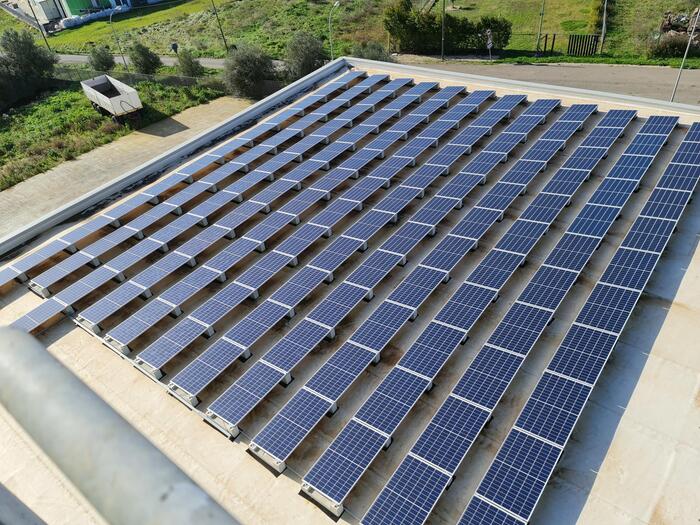A solar power plant in Amareleja, Portugal, in a file image.Jose Manuel Ribeiro / Reuters
The transition to renewables is being less rapid than what is required to mitigate the effects against climate change, but the move from fossil fuels to green is unstoppable.
75% of the new electricity generation capacity installed in 2019 around the world was solar, wind or hydroelectric - when a decade ago they only accounted for 40% - and its impulse pushed fossil fuels (gas and coal) to a new All-time low of 25%, according to the latest BloombergNEF data.
The vast majority of the new renewable installations were photovoltaic —45% of the total—, largely thanks to technological advances that have drastically reduced their generation cost and that have multiplied by almost 15 the number of gigawatts from this source that enter in operation every year since 2010. The strength of energy from the sun is also reflected in available capacity: it is already the fourth largest source in the world, only behind coal, gas and hydroelectric power, and ahead of wind power.
At a great distance, yes, from its fossil competitors.
Denmark was last year the world leader in power generation from the sun and wind, with 55% of the total, followed by Ireland (33%), Uruguay (32%), Portugal (28%) and the United Kingdom ( 28%).
Although rich countries dominate the top of that ranking, a handful of emerging nations, with Mauritania (24%), Namibia (21%) and Honduras (19%) have not stopped climbing steps in recent years.
Penetration rates of
wind and solar energy
In %
60
fifty
40
30
twenty
10
0
Denmark
Ireland
Uruguay
Portugal
Spain
Germany
UK
Mauritania
Namibia
Honduras
2010
2012
2014
2016
2018
19
New capacity added
In %
Renewable
Wind and solar
Fossils
100
80
60
40
twenty
0
2010
2012
2014
2016
2018
19
Source: Bloomberg.
THE COUNTRY
Penetration rates of
wind and solar energy
In %
60
fifty
40
30
twenty
10
0
Denmark
Ireland
Uruguay
Portugal
Spain
Germany
UK
Mauritania
Namibia
Honduras
2010
2012
2014
2016
2018
19
New capacity added
In %
Renewable
Wind and solar
Fossils
100
80
60
40
twenty
0
2010
2012
2014
2016
2018
19
Source: Bloomberg.
THE COUNTRY
Penetration rates of
wind and solar energy
New capacity added
In %
Renewable
Wind and solar
Fossils
In %
60
fifty
40
30
twenty
10
0
100
80
60
40
twenty
0
Denmark
Ireland
Uruguay
Portugal
Spain
Germany
UK
Mauritania
Namibia
Honduras
2010
2012
2014
2016
2018
19
2010
2012
2014
2016
2018
19
Source: Bloomberg.
THE COUNTRY
"The sharp drops in the costs of solar equipment - the modules that go on rooftops and in large plants - have made solar photovoltaic technology widely available for homes, businesses and networks," underlines Luiza Demôro, analyst at BloombergNEF and main signatory of the study.
"It is a worldwide phenomenon."
If until a very few years ago solar and wind energy were a thing of rich countries, in recent years both technologies have spread to emerging countries, with four of them (Chile, Colombia, Mexico and Turkey) taking over most of the new ones. projects in the last three years.
However, despite its rapid growth - which will continue in the coming years and which the pandemic has not been able to curb - solar energy still accounts for slightly less than 3% of the electricity generated worldwide.
This is 17 times more than ten years ago, but far less than it would take to reduce emissions at the rate required to slow global warming.
In total, renewable sources accounted for 27% of the energy generated in 2019, seven points more than in 2010.
Renewables advance despite 'free' oil
According to BloombergNEF calculations on data series from 138 countries, carbon dioxide emissions from the energy sector on a global scale fell by 1.5% in the last year, with decreases in the European Union and the United States more than offsetting the sustained increase in China, which already emits 37% of the total.
Emerging companies pull coal with Asian financing
The pullback from coal, by far the most polluting source of generation, offers especially encouraging data in the last year but much less encouraging if the last decade is taken as a reference.
Between 2018 and 2019, the total energy generated from this source fell by 3% due to a mixture of disconnection of the most obsolete plants and those with the lowest start-up of those still existing.
But the world has more coal plants than ten years ago — its growth in emerging countries has more than offset its obsolescence in the rich bloc.
Although operating much less frequently (their utilization rate has gone from 57% to 50% since 2010), they are almost a third more than in 2010.
"The richest countries are quickly withdrawing the oldest and inefficient coal plants because they cannot compete with new gas or renewable energy projects," closes Ethan Zindler, head of BloombergNEF in America.
"However, in less developed countries, especially in South and Southeast Asia, new and more efficient coal plants are still in line, often with financial support from Chinese and Japanese lenders."







